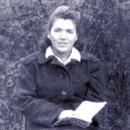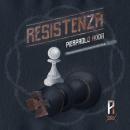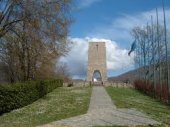װאָלט איך אױפֿגעהאַנגען
דאָס װיגל אױף אַ באַלקן
און געהױדעט, געהױדעט
מײַן ייׅנגעלע, מײַן יאַנקל.
איז די שטוב אַנטרונען
מיט אַ פֿלאַם פֿײַער
װי זשע קען איך הױדען
מײַן ייׅנגעלע, מײַן טײַערן?
װאָלט איך צוגעבונדן
דאָס װיגל אױף אַ בײמל.
און געהױדעט, געהױדעט
מײַן ייׅנגעלע, מײַן שלמהל.
איז מיר ניט פֿאַרבליבן
קײן פֿאָדעם פֿון קײן ציך,
איז מיר ניט גערבליבן, גערבליבן
קײן בענדל פֿון קײן שיך.
װאָלט איך אָפּגעשאָרן
די צעפּ מײַנע, די לאַנגע,
און אױף זײ דאָס װיגל,
דאָס װיגל אױף אַ בײמל.
װײז איך ניט, װוּ זוכן
די בײנדעלעך אַצינדער,
די בײנדעלעך, די טײַערע,
פֿון בײדע מײַנע קינדער.
װאָלט איך צוגעבונדן
דאָס װיגל אױף אַ בײמל.
און געהױדעט, געהױדעט
מײַן ייׅנגעלע, מײַן שלמהל.
העלפֿט מיר, טאַמעס, העלפֿט מיר
אױסקלאָגן מײַנע ניגן.
העלפֿט מיר, טאַמעס, אָה העלפֿט מיר
דעם בּאַבּי יאַר פֿאַרװיגן.
דאָס װיגל אױף אַ באַלקן
און געהױדעט, געהױדעט
מײַן ייׅנגעלע, מײַן יאַנקל.
איז די שטוב אַנטרונען
מיט אַ פֿלאַם פֿײַער
װי זשע קען איך הױדען
מײַן ייׅנגעלע, מײַן טײַערן?
װאָלט איך צוגעבונדן
דאָס װיגל אױף אַ בײמל.
און געהױדעט, געהױדעט
מײַן ייׅנגעלע, מײַן שלמהל.
איז מיר ניט פֿאַרבליבן
קײן פֿאָדעם פֿון קײן ציך,
איז מיר ניט גערבליבן, גערבליבן
קײן בענדל פֿון קײן שיך.
װאָלט איך אָפּגעשאָרן
די צעפּ מײַנע, די לאַנגע,
און אױף זײ דאָס װיגל,
דאָס װיגל אױף אַ בײמל.
װײז איך ניט, װוּ זוכן
די בײנדעלעך אַצינדער,
די בײנדעלעך, די טײַערע,
פֿון בײדע מײַנע קינדער.
װאָלט איך צוגעבונדן
דאָס װיגל אױף אַ בײמל.
און געהױדעט, געהױדעט
מײַן ייׅנגעלע, מײַן שלמהל.
העלפֿט מיר, טאַמעס, העלפֿט מיר
אױסקלאָגן מײַנע ניגן.
העלפֿט מיר, טאַמעס, אָה העלפֿט מיר
דעם בּאַבּי יאַר פֿאַרװיגן.
inviata da Riccardo Venturi - 19/6/2013 - 12:29
Lingua: Yiddish
La trascrizione in caratteri latini


Shike Driz.
Il testo traslitterato di Babi Yar proviene da Voices of the Holocaust della State College Choral Society. Contiene però alcuni errori di ortografia, che sono stati corretti qui. Inoltre, le strofe hanno spesso, nel testo della Choral Society, un'errata suddivisione dei versi. Ma, del resto, è l'unico testo completo di questa canzone presente in rete e sta a testimoniare una cosa precisa: il "revival" della canzone in yiddish, in un'epoca in cui la conoscenza di questa lingua è divenuta scarsa anche tra gli stessi ebrei. [RV]
BABI YAR
Volt ikh oyfgehangen
dos vigl af a balkn
Un gehoydet, gehoydet
Mayn yingele, mayn Yankl.
Iz di shtub antrunen
Mit a flam fayer
Vi zhe ken ikh hoyden
Mayn yingele, mayn tayern?
Volt ikh tsugebundn
Dos vigl af a beyml.
Un gehoydet, gehoydet
Mayn yingele, mayn Shleyml.
Iz mir nit farblibn
Keyn fodem fun keyn tsikh,
Iz mir nit geblibn, geblibn,
Keyn bendl fun keyn shikh.
Volt ikh opgeshorn
di tsep mayne, di lange,
Un af zey dos vigl,
Dos vigl af a beyml.
Veyz ikh nit, vu zukhn
Di beyndelekh atsinder,
Di beyndelekh, di tayere,
Fun beyde mayne kinder.
Volt ikh tsugebundn
Dos vigl af a beyml.
Un gehoydet, gehoydet
Mayn yingele, mein Shleyml.
Helft mir, mames, helft mir
Oysklogn mayne nign.
Helft mir mames, oh helft mir
Dem Babi Yar farvign.
Volt ikh oyfgehangen
dos vigl af a balkn
Un gehoydet, gehoydet
Mayn yingele, mayn Yankl.
Iz di shtub antrunen
Mit a flam fayer
Vi zhe ken ikh hoyden
Mayn yingele, mayn tayern?
Volt ikh tsugebundn
Dos vigl af a beyml.
Un gehoydet, gehoydet
Mayn yingele, mayn Shleyml.
Iz mir nit farblibn
Keyn fodem fun keyn tsikh,
Iz mir nit geblibn, geblibn,
Keyn bendl fun keyn shikh.
Volt ikh opgeshorn
di tsep mayne, di lange,
Un af zey dos vigl,
Dos vigl af a beyml.
Veyz ikh nit, vu zukhn
Di beyndelekh atsinder,
Di beyndelekh, di tayere,
Fun beyde mayne kinder.
Volt ikh tsugebundn
Dos vigl af a beyml.
Un gehoydet, gehoydet
Mayn yingele, mein Shleyml.
Helft mir, mames, helft mir
Oysklogn mayne nign.
Helft mir mames, oh helft mir
Dem Babi Yar farvign.
inviata da Riccardo Venturi - 19/6/2013 - 12:32
Lingua: Italiano
Traduzione italiana di Riccardo Venturi
21 giugno 2013
21 giugno 2013
BABIJ JAR
Avrei certo appeso
la culla a una trave
e cullato, cullato
il mio bimbo, il mio Yankl.
Ma la capanna in fiamme
è bruciata via;
come posso cullarlo
il mio bimbo adorato?
Avrei certo appeso
la culla a un alberello,
e cullato, cullato
il mio bimbo, il mio Shleyml.
Ma non mi è rimasto
un filo del suo cuscino,
neanche mi è rimasta
una stringa delle sue scarpe.
Mi sarei tagliato
i miei lunghi cernecchi,
e ci avrei appeso
la culla come a un albero.
Ma non so dove cercare
ora le loro ossa,
le ossa adorate
dei miei due bambini.
Avrei certo appeso
la culla a un alberello,
e cullato, cullato
il mio bimbo, il mio Shleyml.
Aiutatemi, mamme,
a tirarmi fuori una melodia,
aiutatemi, mamme,
a cullare il Babij Jar.
Avrei certo appeso
la culla a una trave
e cullato, cullato
il mio bimbo, il mio Yankl.
Ma la capanna in fiamme
è bruciata via;
come posso cullarlo
il mio bimbo adorato?
Avrei certo appeso
la culla a un alberello,
e cullato, cullato
il mio bimbo, il mio Shleyml.
Ma non mi è rimasto
un filo del suo cuscino,
neanche mi è rimasta
una stringa delle sue scarpe.
Mi sarei tagliato
i miei lunghi cernecchi,
e ci avrei appeso
la culla come a un albero.
Ma non so dove cercare
ora le loro ossa,
le ossa adorate
dei miei due bambini.
Avrei certo appeso
la culla a un alberello,
e cullato, cullato
il mio bimbo, il mio Shleyml.
Aiutatemi, mamme,
a tirarmi fuori una melodia,
aiutatemi, mamme,
a cullare il Babij Jar.
Lingua: Inglese
La versione inglese di Aaron Kramer
English translation by Aaron Kramer
English translation by Aaron Kramer
BABI-YAR
I'd have picked the right beam
For a crib to be swung on
And have cradled and cradled
My Yankel, the young one.
But in fire and flame
The hut fell to ashes;
Where then am I to rock
My boy, my precious?
To nettles, thorn and thistles
The village road surrenders;
The hushed white doves
Have been transformed to cinders. *
I'd have chosen a tree;
My cradle would have hung there;
I'd have taken my Shloimel,
Sung him and sung there;
But I've not one thread
Of his pillow-case,
And of his shoes
Not so much as a lace.
Not a twig, not a leaf...
The hearty oak
Is a heap of coals
That smolder and smoke... *
I'd have cut off my braids,
Completely undone them,
And have hung my darlings'
Cradle upon them;
But I don't know where
They are now, the bones -
The priceless bones
Of my two little sons.
Help me, mothers, help me
Tear the music from my breast!
Help me, mothers, help me
rock Babi-Yar to rest!
*These verses are not sung in the musical version.
I'd have picked the right beam
For a crib to be swung on
And have cradled and cradled
My Yankel, the young one.
But in fire and flame
The hut fell to ashes;
Where then am I to rock
My boy, my precious?
To nettles, thorn and thistles
The village road surrenders;
The hushed white doves
Have been transformed to cinders. *
I'd have chosen a tree;
My cradle would have hung there;
I'd have taken my Shloimel,
Sung him and sung there;
But I've not one thread
Of his pillow-case,
And of his shoes
Not so much as a lace.
Not a twig, not a leaf...
The hearty oak
Is a heap of coals
That smolder and smoke... *
I'd have cut off my braids,
Completely undone them,
And have hung my darlings'
Cradle upon them;
But I don't know where
They are now, the bones -
The priceless bones
Of my two little sons.
Help me, mothers, help me
Tear the music from my breast!
Help me, mothers, help me
rock Babi-Yar to rest!
*These verses are not sung in the musical version.
inviata da Riccardo Venturi - 21/6/2013 - 10:32
×
![]()









Testo di Shike Driz (1908-1971)
Lyrics by Shike Driz (1908-1971)
Musica di Rive Boyarska (1894-1967)
Music by Rive Boyarska (1894-1967)
I tedeschi raggiunsero Kiev il 19 settembre 1941. I partigiani e i servizi sovietici dell'NKVD avevano minato una serie di edifici nel centro della città e li fecero esplodere il 24 settembre provocando centinaia di vittime fra le truppe tedesche e lasciando oltre 50.000 civili senza tetto. Il 28 settembre vennero affissi per la città manifesti recanti la dicitura seguente: "Tutti gli ebrei che vivono a Kiev e nei dintorni sono convocati alle ore 8 di lunedì 29 settembre 1941, all'angolo fra le vie Mel'nikovaja e Dokterivskaja (vicino al cimitero). Dovranno portare i propri documenti, danaro, valori, vestiti pesanti, biancheria ecc. Tutti gli ebrei non ottemperanti a queste istruzioni e quelli trovati altrove saranno fucilati. Qualsiasi civile che entri negli appartamenti sgomberati per rubare sarà fucilato."
I più, inclusi i 175.000 della comunità ebraica di Kiev, pensarono che gli ebrei sarebbero stati deportati. Già il 26 settembre invece, in una riunione fra il comandante militare di Kiev, Generalmajor Eberhardti, l'ufficiale comandante l'Einsatzgruppe C, SS-Brigadeführer Dr Otto Rasch, e l'ufficiale comandante il Sonderkommando 4a, SS-Standartenführer Paul Blobel, si era deciso di ucciderli come rappresaglia agli attentati del 24 settembre, ai quali erano peraltro estranei.
Gli ebrei di Kiev si radunarono presso il cimitero, aspettando di essere caricati sui treni. La folla era tale che molti degli uomini, donne e bambini non capivano cosa stesse accadendo e quando udirono il rumore delle mitragliatrici, era troppo tardi per fuggire. Vennero condotti in gruppi di dieci attraverso un corridoio di soldati, come descritto da A. Kuznetsov:
Gli ebrei furono obbligati a spogliarsi, picchiati se resistevano, infine uccisi con armi da fuoco sull'orlo del burrone. Secondo l'Einsatzbefehl der Einsatzgruppe Nr. 101, almeno 33.771 ebrei da Kiev e dintorni vennero trucidati a Babij Jar fra il 29 e il 30 settembre 1941: abbattuti sistematicamente con le mitragliatrici. Almeno 60.000 persone, inclusi rom e prigionieri di guerra russi vennero uccisi in seguito in questo sito. Esecutore del massacro fu l'Einsatzgruppe C, supportato da membri del battaglione Waffen-SS e da unità della polizia ausiliaria ucraina. La partecipazione di collaborazionisti a questi eventi, oggi documentata e provata, è tema di un pubblico e doloroso dibattito in Ucraina.
All'avvicinarsi dell'Armata Rossa, nell'agosto del 1943 i nazisti cercarono di occultare le prove del massacro. I reparti della Sonderaktion 1005 al comando di Paul Blobel impiegarono 327 prigionieri per esumare e bruciare i corpi. I prigionieri portarono a termine il compito in sei settimane.
Quelli troppo malati o troppo lenti furono fucilati sul posto. Un militare della Schutzpolizei testimoniò: